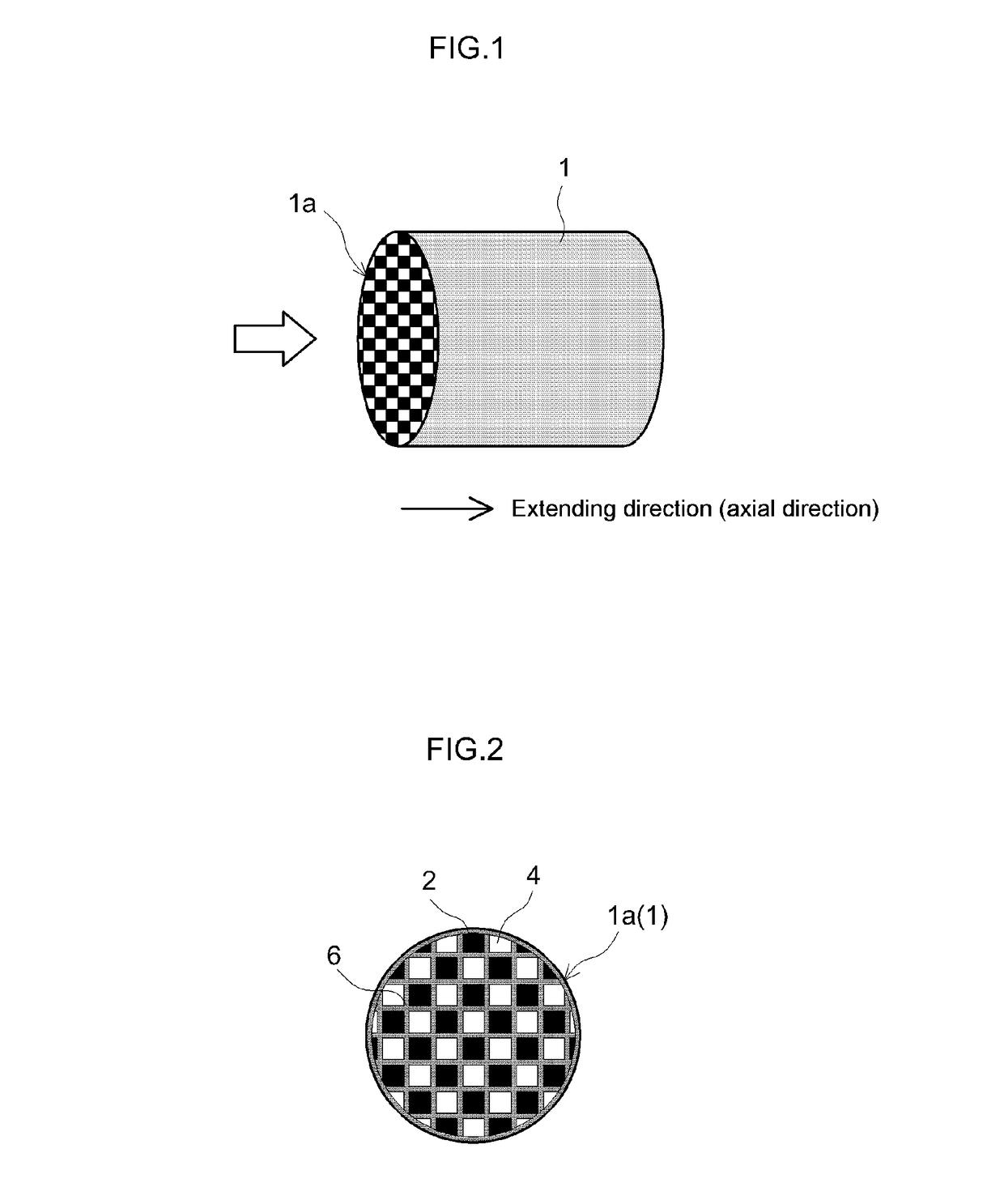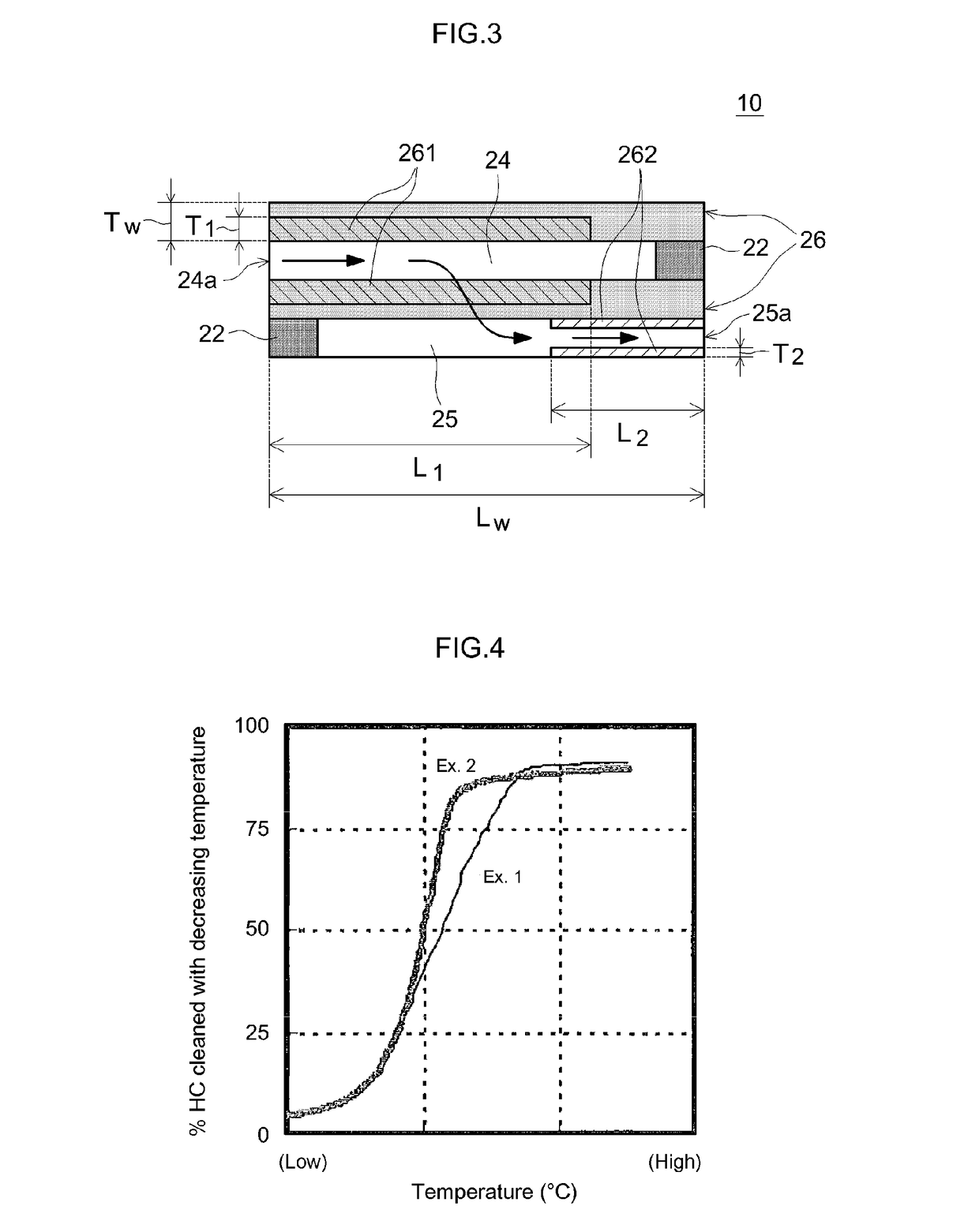Exhaust gas purification catalyst
a technology of exhaust gas and catalyst, which is applied in the direction of physical/chemical process catalysts, separation processes, machines/engines, etc., can solve the problems of excessive pressure loss, achieve high exhaust gas purification performance, reduce the effect of exhaust emissions, and reduce the increase of pressure loss
- Summary
- Abstract
- Description
- Claims
- Application Information
AI Technical Summary
Benefits of technology
Problems solved by technology
Method used
Image
Examples
example 1
[0059]As the substrate, was obtained a cordierite honeycomb substrate of 300 cpsi (cells per square inch) in the number of cells, 0.9 L in volume (referring to the total bulk volume including the volumes of cell channels), 105 mm in total length, 103 mm in outer diameter, 0.3 mm in partition wall thickness, 15 μm in average pore diameter and 59% in porosity.
[0060]Subsequently, were mixed 40 g of Al2O3 powder (γ-Al2O3, 1 μm average particle diameter) as a support, an aqueous rhodium solution containing 0.5 g Rh, and a suitable amount of pure water. The resulting mixture was mixed with stirring, dried and calcined (500° C., 1 hour) to obtain Rh-carrying powder. With the Rh-carrying powder, were mixed a ceria-zirconia composite oxide solution to yield 60 g of CZ composite oxide upon calcination, and a suitable amount of pure water to prepare the first catalytic layer-forming slurry. The first catalytic layer-forming slurry was supplied from the exhaust inlet-side ends of the honeycomb ...
example 2
[0063]The second catalytic layer was provided to the surface of the partition walls facing the exit cells. Otherwise in the same manner as Example 1, an exhaust gas purification catalyst (Example 2) was fabricated. In Example 2, because of a difference in features (average particle diameters) of Al2O3 powder as the support, the first catalytic layer was formed in the interior of the partition walls while the second catalytic layer was formed on the surface of the partition walls facing the exit cells. With respect to the second catalytic layer, the length L2 in the extending direction is 55% of the entire partition wall length and the thickness T2 is 20% of the entire partition wall thickness.
[0064]The characteristics of the exhaust gas purification catalysts of the respective Examples are summarized in Table 1 below.
[0065]
TABLE 1Studies on where catalytic layers are formed1st catalytic layer2nd catalytic layerLength L1Length L2in runningin runningOverlapCatalyticdirectionCatalyticd...
example 3
[0072]The length L1 of the first catalytic layer in its extending direction was 80% of the entire partition wall length and the length L2 of the second catalytic layer in its extending direction was 50% of the entire partition wall length. Otherwise in the same manner as I. Example 2 above, an exhaust gas purification catalyst (Example 3) was fabricated, in which the first catalytic layer was formed in the interior of the partition walls and the second catalytic layer was formed on the surface of the partition walls facing the exit cells.
PUM
| Property | Measurement | Unit |
|---|---|---|
| temperature | aaaaa | aaaaa |
| total cell volume | aaaaa | aaaaa |
| total cell volume | aaaaa | aaaaa |
Abstract
Description
Claims
Application Information
 Login to View More
Login to View More - R&D
- Intellectual Property
- Life Sciences
- Materials
- Tech Scout
- Unparalleled Data Quality
- Higher Quality Content
- 60% Fewer Hallucinations
Browse by: Latest US Patents, China's latest patents, Technical Efficacy Thesaurus, Application Domain, Technology Topic, Popular Technical Reports.
© 2025 PatSnap. All rights reserved.Legal|Privacy policy|Modern Slavery Act Transparency Statement|Sitemap|About US| Contact US: help@patsnap.com


